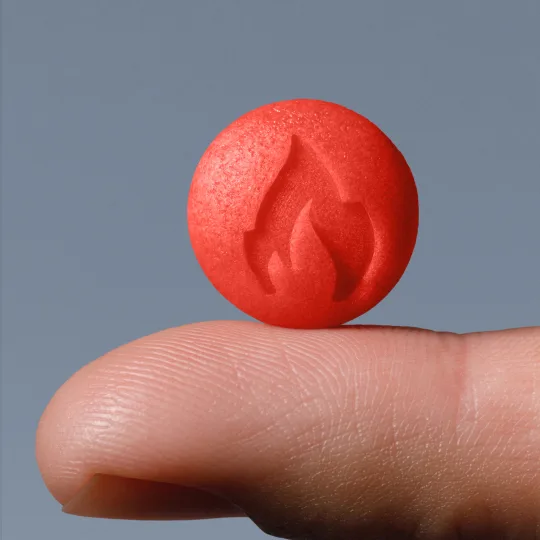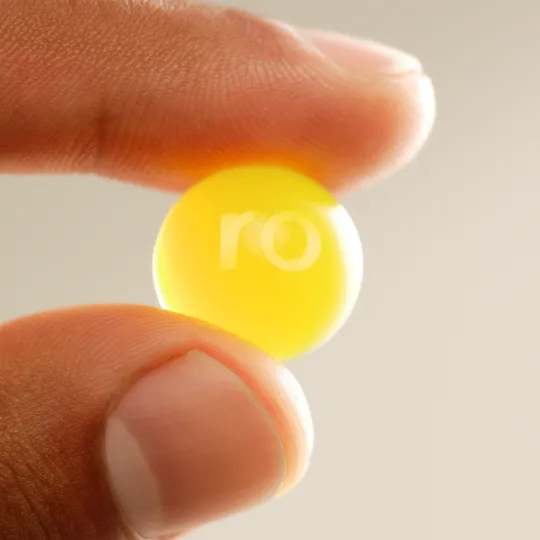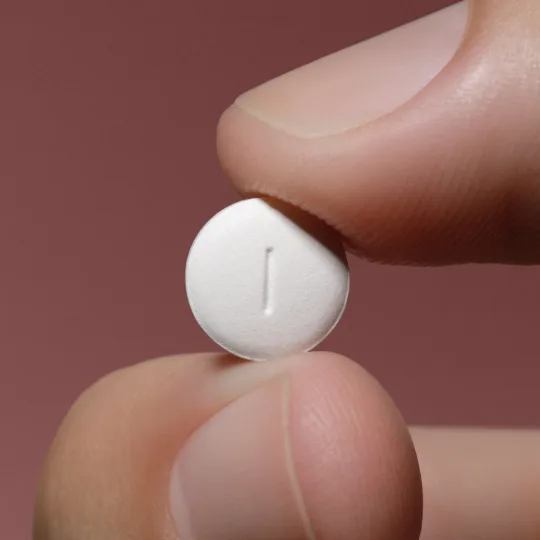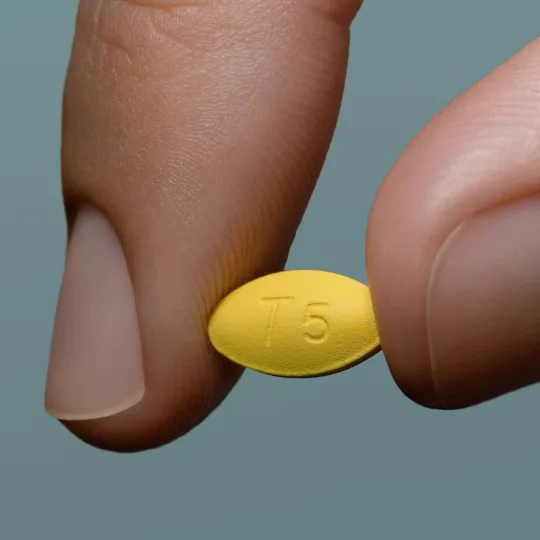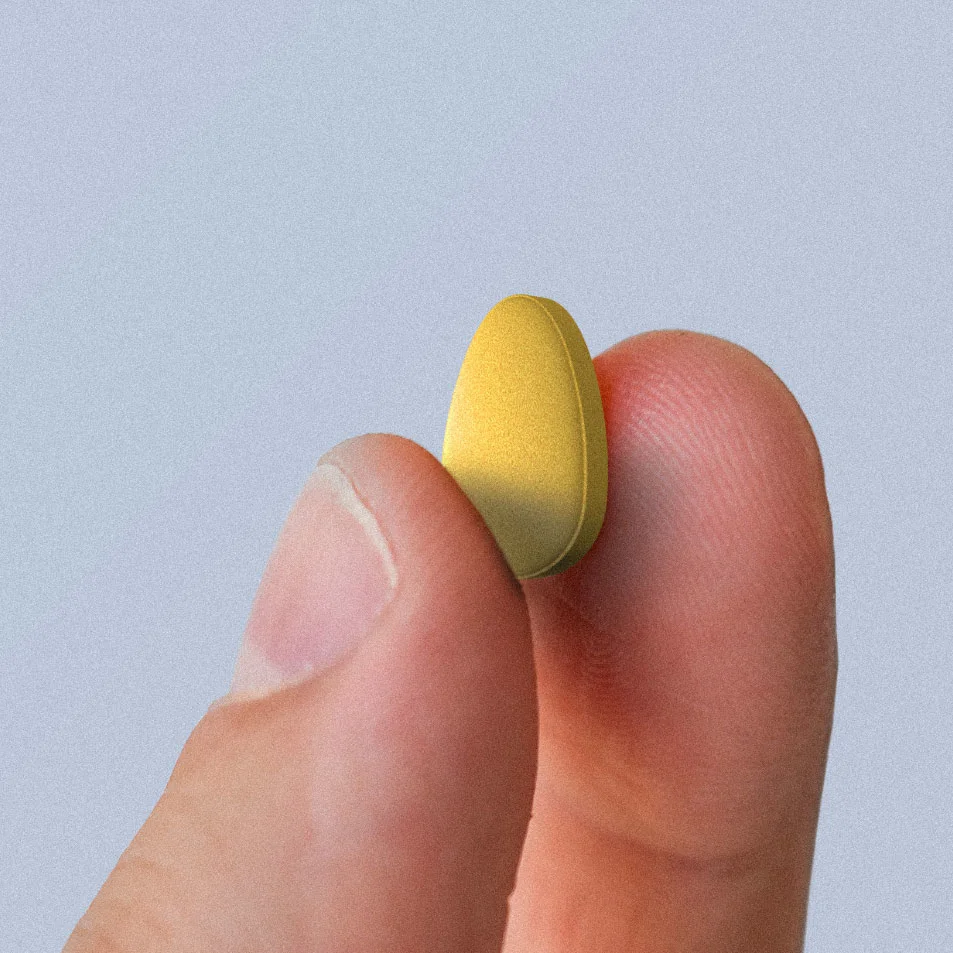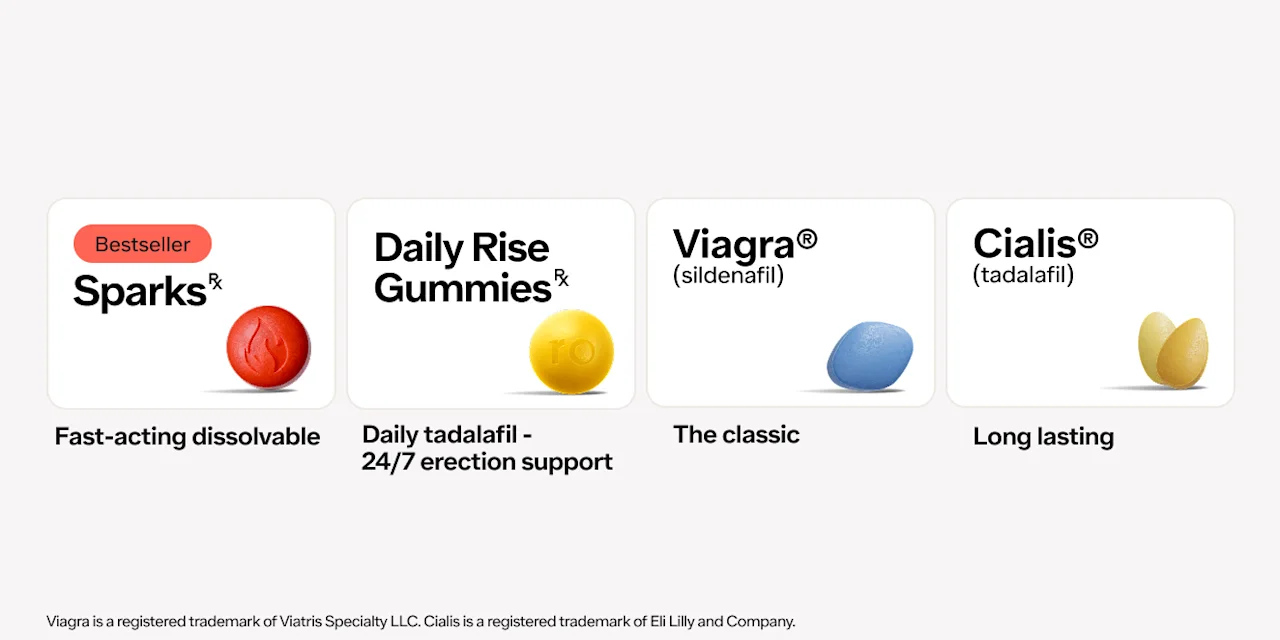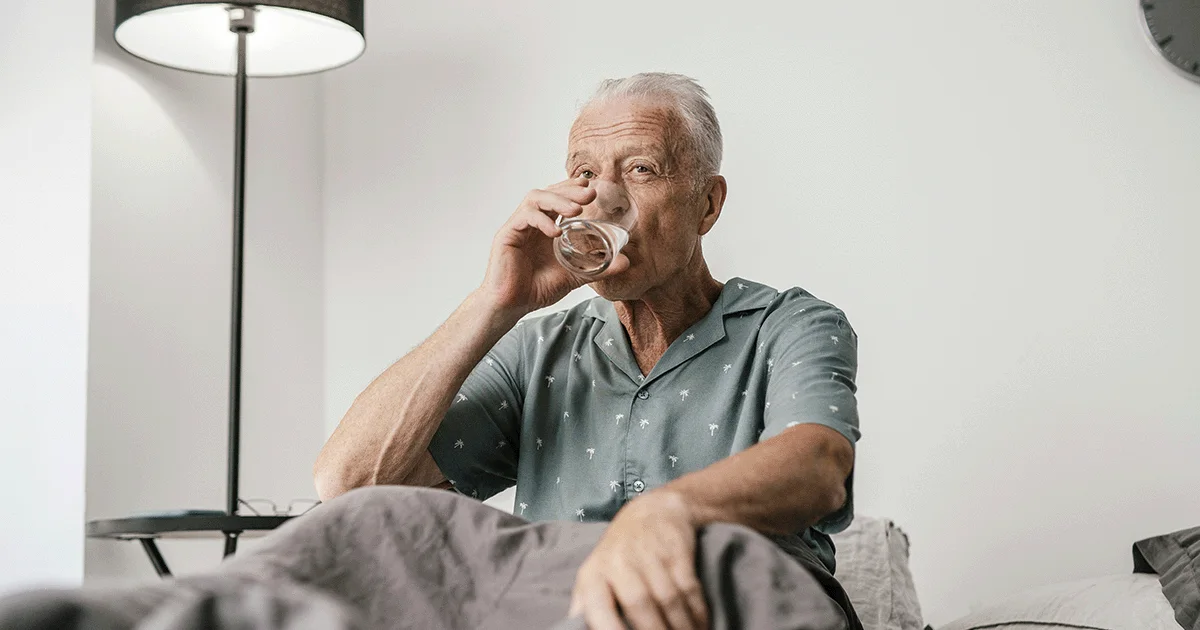Key takeaways
Oftentimes, erectile dysfunction (ED) can be reversed, but it largely depends on the cause of the condition. In some cases, ED can be reversed with lifestyle changes like exercise, diet, and weight management.
In situations where ED is not reversible, it’s still often treatable with medications like Viagra and Cialis. Experts suggest a combination of medication and lifestyle changes to be most effective for managing ED.
It’s important to speak to a healthcare provider if you’re experiencing ED, as it could be an early sign of a more serious health problem like high blood pressure, diabetes, or heart disease.
Here's what we'll cover
Here's what we'll cover
Here's what we'll cover
Key takeaways
Oftentimes, erectile dysfunction (ED) can be reversed, but it largely depends on the cause of the condition. In some cases, ED can be reversed with lifestyle changes like exercise, diet, and weight management.
In situations where ED is not reversible, it’s still often treatable with medications like Viagra and Cialis. Experts suggest a combination of medication and lifestyle changes to be most effective for managing ED.
It’s important to speak to a healthcare provider if you’re experiencing ED, as it could be an early sign of a more serious health problem like high blood pressure, diabetes, or heart disease.
An estimated 322 million people worldwide are affected by erectile dysfunction (ED), making it the most common type of sexual dysfunction among people assigned male at birth (typically men). Despite its prevalence, experiencing ED can be distressing and lead to a lot of questions, including (but not limited to) “Can erectile dysfunction be reversed?” and “Is it permanent?”
ED is a complicated condition that can have multiple underlying causes, but the good news is that many men can—and often do—find a treatment that works for them. And guess what? In some cases, ED can be reversed completely. While there might not be a universal, permanent cure for erectile dysfunction (not yet, at least), here are all the ways you may be able to reverse it.
Can erectile dysfunction be reversed?
Yes, some cases of erectile dysfunction can be reversed once the underlying cause is addressed. That said, whether or not you can reverse ED really depends on the cause(s) of the condition. For example, if you’re taking a medication that’s affecting erectile function, stopping or switching may rectify your down-there difficulties. (Remember, though, you should never stop or adjust your medication regimen without first speaking to a healthcare provider.)
“Research consistently demonstrates that comprehensive lifestyle interventions can dramatically improve sexual health—and are paramount in preventing and managing erectile dysfunction,” says Faysal Yafi, MD, an associate professor of urology and medical director of the Department of Urology’s Men's Health Program at the University of California, Irvine.
Medication-induced ED is considered easier to reverse (unless you’re unable to stop the drug causing it). Reversing ED through lifestyle changes, however, is usually a longer-term process that can take anywhere from months to years. Mild to moderate ED has a higher chance of being reversed than advanced cases of ED, which are often still treatable but may require more significant medical intervention.
Have better sex with Ro
Can erectile dysfunction be cured?
Yes, theoretically, ED can be cured. But again, it all comes down to the cause. If a medication is the culprit, scientific literature suggests that changing or stopping it should restore erectile function. If a hormonal imbalance is causing erectile problems, the right treatment should solve it. For example, studies have found that men diagnosed with low testosterone saw marked improvements in erectile function after starting testosterone therapy.
Unfortunately, there are other scenarios where there is no permanent cure for erectile dysfunction. Nerve damage, chronic health conditions, surgical procedures, and certain medical treatments can all result in ED that’s either irreversible or much more difficult to reverse.
A common one is prostate cancer treatment; in one study, 60% of patients reported erectile problems following prostate cancer surgery. That’s because treatments for prostate cancer—including surgery, hormone therapy, and radiation—can damage or destroy nerves important for erectile function.
Moderate to severe ED, which is characterized by persistently being unable to achieve or sustain an erection long enough for satisfactory sex, is complicated and may not be curable. But many cases can still be successfully treated with the right medical care. It’s important to catch ED early as it can worsen (and become harder to treat) over time if left untreated, Dr. Yafi says.
“Persistent ED lasting more than 3-6 months should be evaluated,” Dr. Yafi says. “This is particularly important if accompanied by cardiovascular symptoms, diabetes indicators, hormonal imbalance signs, or psychological distress.”
Ways to reverse erectile dysfunction
Now that you know it’s possible to reverse ED, the next big question is, “how?” For some people, ED can be reversed with medication adjustments or lifestyle changes like quitting smoking and exercising more. It’s important to work with a healthcare provider to figure out the underlying cause (or causes) of your condition so they can recommend the right treatment.
As mentioned, some cases of the condition are more complicated and may require medication or more advanced forms of treatment. That said, here are some strategies you can try that may help reverse your ED.
Exercise often
Getting enough exercise isn’t just good for overall health; it can improve erectile health, too. In fact, physical inactivity is a well-established, reversible risk factor for ED, and research shows that increasing physical activity can improve erectile function and wellbeing.
“Regular physical exercise emerges as a critical factor, with studies showing that men who engage in daily physical activity can greatly reduce their ED risk,” Dr. Yafi says.
Exercise encourages healthy blood flow, which is crucial for getting an erection. Along with being an important promoter of heart and blood vessel health, studies show that regular exercise can also enhance the production of nitric oxide, a natural compound in the body responsible for dilating blood vessels and encouraging blood flow to the penis.
Research indicates regular exercise may be able to reverse mild to moderate ED caused by vascular issues over time. One study found that 40 minutes of moderate to vigorous aerobic exercise (e.g. jogging, swimming, cycling) four times a week improved erectile function in men experiencing vascular ED.
Keep in mind that exercise alone may not be enough to reverse ED; studies suggest that a combination of lifestyle factors, including diet and weight management, can be the most effective in reversing ED or reducing symptoms.
Make certain dietary changes
While no one food will fix or cure ED, what you eat can play a significant role in erectile function, Dr. Yafi says. Research finds that regularly consuming processed foods and foods high in saturated fat can lead to high cholesterol and plaque buildup in arteries—two factors that can negatively impact blood flow everywhere, including down there.
So, if you’re wondering “can erectile dysfunction be reversed?” consider heeding Dr. Yasi’s advice to “adopt a balanced, nutritious diet.”
“Nutritional strategies should focus on nitrate-rich foods, omega-3 fatty acids, and antioxidant-rich options while reducing processed foods and saturated fats,” he explains.
Studies have found that the Mediterranean diet, which emphasizes whole grains, fruits, vegetables, and lean proteins, to be most effective for preventing ED. There’s not enough research to say whether healthy eating patterns alone can reverse ED. But studies do show that improving diet quality can help prevent or treat ED when combined with other lifestyle changes like getting more exercise and quitting smoking. (In case you missed it, a mixture of methods can be essential to seeing success when treating or reversing ED, at least according to science.)
Quit smoking
It’s pretty well known that smoking is bad for you, and yes, that applies to erections as well. Studies have shown that harmful chemicals found in cigarettes, such as nicotine and carbon monoxide, can damage blood vessels throughout the body, including in the penis. This can lead to restricted blood flow to the area.
Though more research is needed, current evidence suggests that stopping smoking can reverse ED. As for cannabis? The research is mixed. Some studies suggest that ED is twice as prevalent in men who smoke marijuana, while other research concludes it has no significant negative effects on sexual function. Further research is required to improve our understanding of the relationship between cannabis and ED.
Limit alcohol consumption
Chronic or excessive alcohol use can impact erectile function. People dependent on alcohol commonly report experiencing sexual dysfunction, including ED, low sex drive, and ejaculation issues. Alcohol is a depressant that affects the central nervous system and can interfere with the brain signals involved in sexual arousal. Long-term use of alcohol has also been shown to decrease testosterone levels, which can lead to ED.
Further study is warranted, but research indicates that ED caused by long-term alcohol use can be reversed. Similar to smoking, studies have shown that abstaining from alcohol improved ED symptoms in men with alcohol use disorder.
While heavy drinking has been closely linked to ED, you don’t have to knock back a bunch of booze regularly to experience sexual side effects. “Even moderate alcohol consumption can reduce erectile function,” Dr. Yafi says.
That’s why when it comes to ways to reverse ED, “alcohol reduction is crucial,” according to Dr. Yafi.
Weight management
Another lifestyle change that could potentially help reverse ED is weight loss. Obesity is associated with a higher risk for moderate to severe ED; some studies report that up to 42% of men with obesity experience ED. Excess body fat can contribute to ED by causing problems with blood circulation and lowering testosterone levels. It can also increase the risk for more serious health conditions like heart disease and diabetes—two conditions that are linked to ED.
“Particularly promising is the impact of weight management—even a modest 10% weight loss can restore erectile function in many overweight individuals,” Dr. Yafi says. “Each point reduction in body mass index can potentially improve sexual function.”
Research backs this up, with one study showing that 15% weight loss in men with obesity significantly improved erectile function. Meaningful weight loss can often be achieved through diet and exercise, but more advanced cases may require prescription weight loss medication (e.g. Zepbound, Wegovy) or bariatric surgery in conjunction with lifestyle changes.
Pelvic floor exercises
Pelvic floor exercises, also known as Kegel exercises, are an easy, low-impact strategy that may boost sexual function. As the name suggests, these strength-training moves target muscles surrounding the pelvis and are often recommended for people with bladder and bowel control issues and pelvic organ prolapse.
Doing Kegel exercises on their own isn’t likely to reverse ED, but they may contribute to improved sexual function. Studies are limited, but there is some evidence that pelvic floor exercises may help with ED and premature ejaculation by strengthening muscles and encouraging better blood circulation in the area. They’re also very easy to do: just squeeze (as if you’re holding in urine or drawing your penis up and in) and release. Pelvic floor treatments appear to be most effective for ED associated with the condition known as chronic prostatitis, which is typically more of a muscle problem than a prostate issue.
Stress reduction
While it may manifest physically, ED doesn’t always have a physical cause. It can also be triggered by emotional or psychological issues, including anxiety, depression, low self-esteem, performance anxiety, and relationship problems. If your ED is caused by mental health issues, taking steps to manage stress and your overall mental health—which may include therapy and/or medication—could help reverse it.
“Stress reduction cannot be overlooked,” Dr. Yafi says. “Chronic stress elevates cortisol levels, which can negatively impact testosterone and sexual function. In clinical studies, mindfulness and meditation techniques have demonstrated a significant improvement in erectile function.”
Everyone has different tactics for alleviating stress, but ones scientifically backed for wellbeing include the aforementioned meditation as well as deep breathing, progressive muscle relaxation, yoga, going for walks, spending time in nature, and making room for quality time with loved ones or pets.
Though sex therapy and stress management techniques may improve your sex life, they’re not always a sure ED cure. That’s because ED is a complicated condition that can be caused by a mix of psychological and physical factors. While research is mixed on the best way to manage psychogenic ED, studies have found the most effective treatment to be a combination of prescription medications, such as Viagra (sildenafil) and Cialis (tadalafil), and psychological interventions. Along with encouraging more blood flow to the penis, studies have also found these medications to boost confidence, which may alleviate psychological stress around sex.
Though ED medications on their own may help address some of the physical symptoms of ED, they won’t address the root cause if it is truly psychological, which is why therapy may be an important part of your treatment plan. A clue that you could be dealing with psychogenic ED could be if you are still experiencing nighttime and morning erections, and only having issues when it comes to sexual activity. In some cases, medications to manage the underlying mental health issue may be necessary.
Get quality sleep
As you may have experienced personally, a good night’s sleep cannot be underestimated. Sleep is critical for the healthy functioning of every system in the body; inconsistent or disrupted shut-eye has been linked to numerous health problems, including high blood pressure, depression, obesity, cognition issues, and—you guessed it—ED.
The link between poor sleep and erectile function isn’t fully understood, but studies suggest sleep deprivation can lead to hormonal imbalances such as decreased testosterone production. Shift work, jet lag, and obstructive sleep apnea—all of which tend to be characterized by a lack of zzz’s—have all been linked to a higher prevalence of ED.
More research is needed, but studies suggest treating underlying sleep issues may reverse ED in some cases. For example, studies have found that treating sleep apnea using a CPAP machine yielded significant improvements in erectile function.
If you’re struggling with falling asleep or inconsistent sleep, modifying your routine (such as reducing screen exposure and avoiding caffeine before sleep) may help. And if these smaller DIY tactics don’t seem to help your nighttime woes, be sure to consult a healthcare provider. They’re best equipped to determine what might be causing your sleep struggles and how to best address them—and, in doing so, hopefully address your ED as well.
Look into your medication
As mentioned above, sexual dysfunction can be a side effect of certain medications. Medication-induced ED is quite common and can happen with a wide range of prescription drugs. The medications that have the highest frequency of ED include:
Benign prostatic hyperplasia and hair loss medications, such as finasteride
Antidepressants, particularly selective serotonin reuptake inhibitors (SSRIs)
Antiepileptics, such as gabapentin and topiramate
Antihistamines, such as diphenhydramine (Benadryl)
Pain medications and sedatives, such as oxycodone
Blood pressure medications, such as spironolactone or beta-blockers
Acid reflux medications, such as famotidine (Pepcid) and ranitidine (Zantac)
It’s also worth noting that other medical therapies that have been shown to cause down-there difficulties are stimulants, such as amphetamine (Adderall), chemotherapy, and radiation.
Stopping or adjusting medication doses—under the guidance of a healthcare professional!— may improve erectile function or even reverse ED. But, again, never stop or change any medication without speaking to your healthcare provider first, as it could pose a risk for serious side effects.
Experimental approaches to reverse ED
In addition to the more traditional ways of reversing ED (such as those above), there are also emerging or experimental treatments that aim to target the condition in new ways. These options have largely been used to treat ED in studies (vs. real-life applications).
Low-intensity shockwave therapy
Low-intensity shockwave therapy (LiSWT) usually involves a series of noninvasive treatments during which a practitioner uses a handheld medical tool to deliver low-intensity shockwaves to the base of the penis. It appears to work most effectively when ED has occured because of impaired blood flow to the penis—so-called “arteriogenic” ED. That might be because the shockwaves delivered during LiSWT may encourage more blood flow to the penis by boosting blood vessel function and to stimulate the formation of new blood vessels in the penis. Studies to date have not proven this treatment to be effective, and it may need to be repeated, but some suggestion of efficacy exists.
Platelet-rich plasma (PRP) or stem cell injections
Platelet-rich plasma (PRP) is plasma (i.e. the liquid portion of blood) that contains a high concentration of platelets, cell fragments rich in growth factors that can help with healing and tissue regeneration. It’s created by drawing blood and then processing the sample in a centrifuge to separate and concentrate the platelets. In the case of ED, PRP is injected into the tissue of the penis, potentially increasing blood flow to the area and, in turn, enhancing erectile function.
Similarly, stem cells can also be extracted from the body and then injected into the penis, where they may help restore dysfunctional muscle or cells of the blood vessel lining—two effects that could address ED.
Stem cell therapies have not effectively treated erectile dysfunction, nor are they approved for use by the FDA. Guidelines written for healthcare providers on how to treat erectile dysfunction do not recommend using these treatments except in carefully controlled experiments. Further information on these investigational treatments is evolving.
PRP and LiSWT treatments are considered experimental because there have been limited results published to date, and the benefits of treatment, if any, are not clear.
Other ways to treat erectile dysfunction
If lifestyle changes aren’t working, don’t despair—there are lots of other effective methods for treating ED. The first-line treatment for ED is often prescription medication, specifically PDE5 inhibitors, which facilitate erections in part by dilating blood vessels and increasing blood flow to the penis. Here are the most common ED pills—all approved by the US Food and Drug Administration (FDA):
Viagra (sildenafil). Approved in 1998, Viagra is the “OG” ED treatment. Sildenafil is the generic version of Viagra that works in the exact same way but is typically a lot cheaper than the brand-name version.
Cialis (tadalafil). Another popular option for treating ED is Cialis (tadalafil being the generic and more cost-effective version). Cialis has been found to be just as effective as Viagra and may last longer (up to 36 hours). Some may prefer this medication due to the option for daily dosing instead of as-needed.
Vardenafil. This PDE5 inhibitor is only available in generic form, though you may know it by its now-discontinued brand name of Levitra. It usually starts working in about 30–60 minutes.
Stendra (avanafil). The most recently approved medication for ED, Stendra, is fast-acting and usually starts working within 15 minutes.
In addition to the aforementioned pills, you can also find some PDE5 inhibitors in newer formulations. While these formulations are not specifically FDA-approved, their active ingredients have been FDA-approved for ED. Two examples—both of which also require a prescription—include:
Daily Rise Gummies. These fruit-flavored gummies contain tadalafil (the active ingredient in Cialis) and are taken daily (vs. as-needed) to allow for more spontaneity.
Ro Sparks. Made with sildenafil and tadalafil (the active ingredients in Viagra and Cialis, respectively), this 2-in-1 treatment dissolves under the tongue for fast-acting effects.
Keep in mind that these medications are not a permanent cure for erectile dysfunction, but they can certainly help alleviate symptoms.
“For men already using prescription ED medications, lifestyle approaches can also enhance treatment effectiveness,” Dr. Yafi says. In other words, don’t understand the power of combining treatments—something he emphasizes.
While oral medications are commonly discussed for the treatment of ED, there are also injectable medications that can be useful for those who do not respond to oral treatments.
Severe or medication-resistant ED can still be treatable, but may require a more intensive approach. A non-surgical option is a penis pump or vacuum erection device, which uses a suction chamber to usher more blood to the penis. Studies have found these devices to be particularly helpful for men who’ve undergone prostate removal surgery. Sometimes this treatment is combined with oral medication for a more noticeable effect.
Depending on the severity of your condition, your healthcare provider may also recommend a bit of a more invasive treatment: a penile implant. This is a surgical procedure that involves implanting an inflatable or flexible device designed to mimic an erection.
What types of erectile dysfunction are permanent?
Though ED can cause a great deal of distress and can be complicated to treat, the good news is it’s usually not permanent. Even in cases where ED is irreversible (for example, ED resulting from nerve damage or surgery), it’s still often treatable with medication, medical devices (e.g. penis pump), or surgery.
However, there are some situations where ED can last for life. Severe nerve damage due to injury, surgery, or certain health conditions may result in permanent ED. For example, advanced kidney disease and diabetes-related complications like peripheral neuropathy can lead to irreversible nerve damage. As mentioned, removal of the prostate gland or prostate cancer treatment can also cause significant trauma to the area that may result in permanent ED.
Other issues like Peyronie’s disease (abnormal curvature of the penis) and scar tissue in the penis can cause more complicated cases of ED. Still, they’re not always permanent and may be able to be treated with medication or surgery.
Bottom line
ED is often caused by a combination of factors—some that can be reversed and others that can’t. Though ED may not always be reversible, it is often treatable. Here are some things to keep in mind about reversing ED:
It may be possible to reverse ED through lifestyle changes, such as getting regular exercise, eating a healthy diet, losing weight, managing stress, quitting smoking, and cutting back or eliminating alcohol.
Certain medications can also cause ED, and stopping, switching, or adjusting your Rx may restore erectile function. But please remember never to take matters into your own hands, no matter how frustrated you might be by your sexual function or lack thereof. Always consult a healthcare provider before tweaking your treatment.
Low intensity shock wave (LiSWT), platelet-rich plasma (PRP) injections, or stem cell injections are considered experimental, so their role in reversing ED has not been proven. So far, they have been used to treat erectile dysfunction in research studies, but their value has not yet been proven for most men with ED.
To successfully treat (or reverse) ED, it’s important to determine the underlying cause. If you’re experiencing symptoms of ED, speak to a healthcare provider who can help figure out what might be to blame for your down-there difficulties and recommend an appropriate course of treatment, which might very well involve multiple methods. (One more time for the folks in the back: Combining treatments has been shown to be effective at reversing or treating ED.)
Frequently asked questions (FAQs)
How can I reverse ED naturally?
While ED can’t always be reversed, there are several natural remedies you can try before exploring medical interventions—although it’s always best to do so under the care and guidance of a healthcare provider. A combination of lifestyle changes is often your best bet for reversing ED naturally. Eating nutritiously, getting regular exercise, managing stress, and cutting out any unhealthy habits like smoking are all-natural ways to combat ED.
What is the fastest way to cure erectile dysfunction?
Everyone experiences the condition differently, which means there isn’t a universal cure for ED. However, in some cases, ED is reversible. Again, it usually requires a combination of healthy lifestyle changes in tandem with medication. ED medications like Viagra and Cialis aren’t meant to cure ED, but they can successfully alleviate symptoms in the short term while you implement longer-term strategies like weight loss or treatment for any chronic conditions that may be behind your symptoms.
What is the main cause of erectile dysfunction?
There are many causes of ED, and often, a combination of causes is to blame for down-there difficulties. That said, the main one is vascular issues. Anything that impacts or disrupts blood flow is likely to have a negative impact on your erections. ED is highly prevalent in individuals with health conditions that impact blood vessel health, such as high blood pressure, high cholesterol, heart disease, obesity, and diabetes.
How can I regain my erectile strength?
Many strategies can improve erectile strength and overall function. Lifestyle changes for stronger erections include regular physical activity, pelvic floor exercises, following a healthy diet, and managing weight. FDA-approved ED medications such as PDE-5 inhibitors can also be very effective at bolstering erections.
DISCLAIMER
If you have any medical questions or concerns, please talk to your healthcare provider. The articles on Health Guide are underpinned by peer-reviewed research and information drawn from medical societies and governmental agencies. However, they are not a substitute for professional medical advice, diagnosis, or treatment.
Zepbound Important Safety Information: Read more about serious warnings and safety info.
Wegovy Important Safety Information: Read more about serious warnings and safety info.
Viagra Important Safety Information: Read more about serious warnings and safety info.
Cialis Important Safety Information: Read more about serious warnings and safety info.
Finasteride Important Safety Information: Read more about serious warnings and safety info.
References
Allen, M. & Tostes, R. (2023). Cigarette smoking and erectile dysfunction: an updated review with a focus on pathophysiology, e-cigarettes, and smoking cessation. Sexual Medicine Reviews, 11(1), 61-73. https://doi.org/10.1093/sxmrev/qeac007. Retrieved from https://academic.oup.com/smr/article/11/1/61/6985842
Allen, M., Wood, A., & Sheffield, D. (2023). The Psychology of Erectile Dysfunction. Association for Psychological Science, 32(6), 487-193. doi: 10.1177/09637214231192269. Retrieved from https://journals.sagepub.com/doi/full/10.1177/09637214231192269
American Urological Association. (2018). Erectile dysfunction (ED) guideline. Retrieved from https://www.auanet.org/guidelines-and-quality/guidelines/erectile-dysfunction-(ed)-guideline
Bauer, S. R., Breyer, B. N., Stampfer, M. J., et al. (2020). Association of Diet With Erectile Dysfunction Among Men in the Health Professionals Follow-up Study. JAMA Network Open, 3(11), e2021701. doi: 10.1001/jamanetworkopen.2020.21701. Retrieved from https://pmc.ncbi.nlm.nih.gov/articles/PMC7666422/
Chao, J. & Hwang, T. (2013). Contemporary management of erectile dysfunction. Urological Science, 24(2), 35-40. doi: 10.1016/j.urols.2013.04.008. Retrieved from https://www.sciencedirect.com/science/article/pii/S1879522613000407
Cohen, D., Gonzalez, J., & Irwin Goldstein, I. (2016). The Role of Pelvic Floor Muscles in Male Sexual Dysfunction and Pelvic Pain. Sexual Medicine Reviews, 4(1), 53-62. doi: 10.1016/j.sxmr.2015.10.001. Retrieved from https://www.sciencedirect.com/science/article/abs/pii/S2050052115000025
Di Francesco, S. & Tenaglia, R. (2017). Mediterranean diet and erectile dysfunction: a current perspective. Central European Journal of Urology, 70(2), 185-187. doi: 10.5173/ceju.2017.1356. Retrieved from https://pmc.ncbi.nlm.nih.gov/articles/PMC5510347/
Du, S., Sun, S., Guo, F., & Liu, H. (2024). Efficacy of platelet-rich plasma in the treatment of erectile dysfunction: A meta-analysis of controlled and single-arm trials. PloS One, 19(11), e0313074. doi: 10.1371/journal.pone.0313074. Retrieved from https://pmc.ncbi.nlm.nih.gov/articles/PMC11563399/
Duca, Y., Calogero, A., Cannarella, R., et al. (2019). Erectile dysfunction, physical activity and physical exercise: Recommendations for clinical practice. Andrologia. doi: 10.1111/and.13264. Retrieved from https://onlinelibrary.wiley.com/doi/10.1111/and.13264
Ergun, O., Kim, K., Kim, M. H., et al. (2023). Low‐intensity shockwave therapy for erectile dysfunction. Cochrane Database of Systematic Reviews, 2023(9), Article CD013166. doi: 10.1002/14651858.CD013166.pub2. Retrieved from https://www.cochranelibrary.com/cdsr/doi/10.1002/14651858.CD013166.pub2/full
Fillo, J., Levcikova, M., Ondrusova, M., et al. (2017). Importance of Different Grades of Abdominal Obesity on Testosterone Level, Erectile Dysfunction, and Clinical Coincidence. American Journal of Men's Health, 11(2), 240-245. doi: 10.1177/1557988316642213. Retrieved from https://pubmed.ncbi.nlm.nih.gov/27184064/
Gerbild, H., Larsen, C. M., Graugaard, C., et al.(2018). Physical Activity to Improve Erectile Function: A Systematic Review of Intervention Studies. Sexual Medicine, 6(2), 75-89. doi: 10.1016/j.esxm.2018.02.001. Retrieved from https://pmc.ncbi.nlm.nih.gov/articles/PMC5960035/
Ghadigaonkar, D. & Murthy, P. (2019). Sexual Dysfunction in Persons With Substance Use Disorders. Journal of Psychosexual Health, 1(2). doi: 10.1177/2631831819849365. Retrieved from https://journals.sagepub.com/doi/full/10.1177/2631831819849365
Hoyland, K., Vasdev, N., & Adshead, J. (2013). The use of vacuum erection devices in erectile dysfunction after radical prostatectomy. Reviews in Urology, 15(2), 67-71. Retrieved from https://pmc.ncbi.nlm.nih.gov/articles/PMC3784970/
Leslie, S. W. & Sooriyamoorthy, T. (2024). Erectile Dysfunction. StatPearls. Retrieved from https://www.ncbi.nlm.nih.gov/books/NBK562253/
Li, T., Bai, Y., Jiang, Y., et al. (2022). Potential Effect of the Circadian Clock on Erectile Dysfunction. Aging and Disease, 13(1), 8-23. doi: 10.14336/AD.2021.0728. Retrieved from https://pmc.ncbi.nlm.nih.gov/articles/PMC8782551/
Maiorino, M. I., Bellastella, G., & Esposito, K. (2015). Lifestyle modifications and erectile dysfunction: what can be expected? Asian Journal of Andrology, 17(1), 5-10. doi: 10.4103/1008-682X.137687. Retrieved from https://pmc.ncbi.nlm.nih.gov/articles/PMC4291878/
Matz, E. L., Pearlman, A. M., & Terlecki, R. P. (2018). Safety and feasibility of platelet rich fibrin matrix injections for treatment of common urologic conditions. Investigative and Clinical Urology, 59(1), 61–65. doi: 10.4111/icu.2018.59.1.61. Retrieved from https://pmc.ncbi.nlm.nih.gov/articles/PMC5754585/
Medrano-Sánchez, E. M., Peña-Cantonero, B., Candón-Ballester, P., et al. (2024). Effectiveness of Low-Intensity Extracorporeal Shock Wave Therapy in Erectile Dysfunction: An Analysis of Sexual Function and Penile Hardness at Erection: An Umbrella Review. Journal of Personalized Medicine, 14(2), 177. doi: 10.3390/jpm14020177. Retrieved from https://pubmed.ncbi.nlm.nih.gov/38392610/
Moore, C. S., Grant, M. D., Zink, T. A., et al. (2014). Erectile dysfunction, vascular risk, and cognitive performance in late middle age. Psychology and Aging, 29(1), 163-172. doi: 10.1037/a0035463. Retrieved from https://pmc.ncbi.nlm.nih.gov/articles/PMC4850828/
Patel, A. A., Shafie, A., Mohamed, A. H., et al. (2025). The promise of mesenchymal stromal/stem cells in erectile dysfunction treatment: A review of current insights and future directions. Stem Cell Research & Therapy, 16, Article 98. doi: 10.1186/s13287-025-03753-4. Retrieved from https://stemcellres.biomedcentral.com/articles/10.1186/s13287-025-04221-9
Pizzol, D., Demurtas, J., Stubbs, B., et al. (2019). Relationship Between Cannabis Use and Erectile Dysfunction: A Systematic Review and Meta-Analysis. American Journal of Men's Health, 13(6), 1557988319892464. doi: 10.1177/1557988319892464. Retrieved from https://pmc.ncbi.nlm.nih.gov/articles/PMC6893937/
Rezali, M. S., Mohamad Anuar, M. F., Abd Razak, M. A., et al. (2023). Prevalence and associated factors of moderate to severe erectile dysfunction among adult men in Malaysia. Scientific Reports, 13(1), 21483. doi: 10.1038/s41598-023-48778-y. Retrieved from https://pmc.ncbi.nlm.nih.gov/articles/PMC10700487/
Rizk, P. J., Kohn, T. P., Pastuszak, A., et al. (2017). Testosterone therapy improves erectile function and libido in hypogonadal men. Current Opinion in Urology, 27(6), 511-515. doi: 10.1097/MOU.0000000000000442. Retrieved from https://pmc.ncbi.nlm.nih.gov/articles/PMC5649360/
Shiff, B., Blankstein, U., Hussaen, J., et al. (2021). The impact of cannabis use on male sexual function: A 10-year, single-center experience. Canadian Urological Association Journal, 15(12), E652–E657. doi: 10.5489/cuaj.7185. Retrieved from https://pmc.ncbi.nlm.nih.gov/articles/PMC8631840/
Sontag, A., Ni, X., Althof, S. E., et al. (2013). Relationship between erectile function and sexual self-confidence: a path analytic model in men being treated with tadalafil. International Journal of Impotence Research, 26, 7-12. Retrieved from https://www.nature.com/articles/ijir201331
Su, L., Zhang, S., Zhu, J., et al. (2021). Effect of partial and total sleep deprivation on serum testosterone in healthy males: a systematic review and meta-analysis. Sleep Medicine, 88, 267-273. doi: 10.1016/j.sleep.2021.10.031. Retrieved from https://www.sciencedirect.com/science/article/abs/pii/S138994572100544X
Wang, C. M., Wu, B. R., Xiang, P., et al. (2023). Management of male erectile dysfunction: From the past to the future. Frontiers in Endocrinology, 14, 1148834. doi: 10.3389/fendo.2023.1148834. Retrieved from https://pmc.ncbi.nlm.nih.gov/articles/PMC10008940/
Worthen, M. & Cash, E. (2023). Stress Management. StatPearls. Retrieved from https://www.ncbi.nlm.nih.gov/books/NBK513300/
Zhou, Z., Chen, H., Wu, J., et al. (2019). Meta-Analysis of the Long-Term Efficacy and Tolerance of Tadalafil Daily Compared With Tadalafil On-Demand in Treating Men With Erectile Dysfunction. Sexual Medicine, 7(3), 282-291. doi: 10.1016/j.esxm.2019.06.006. Retrieved from https://www.sciencedirect.com/science/article/pii/S2050116119300650


